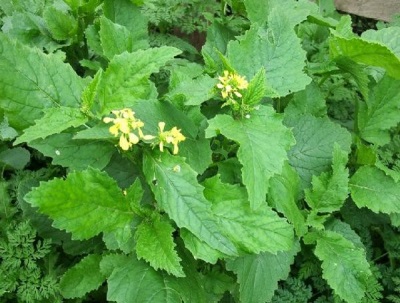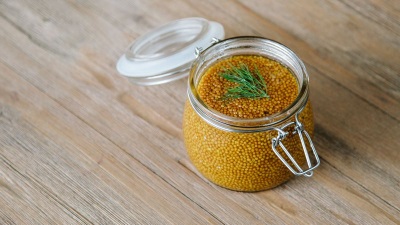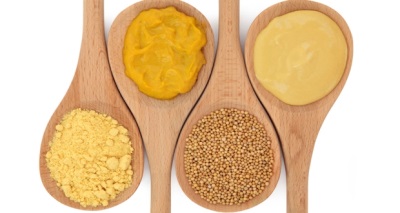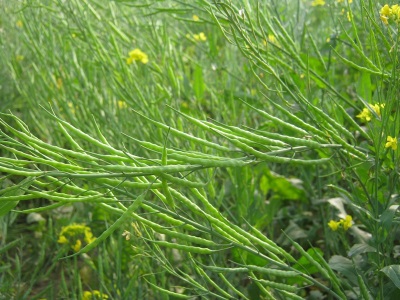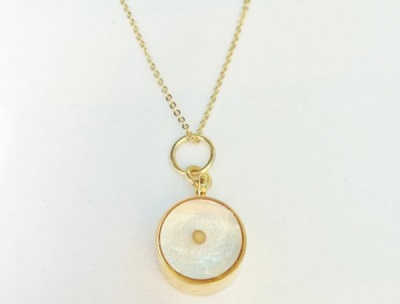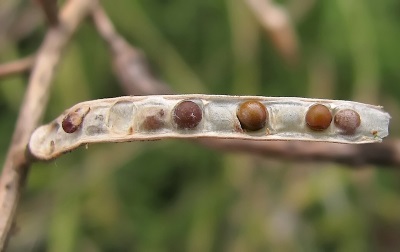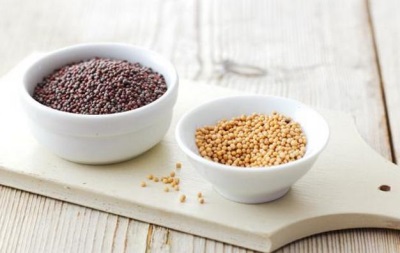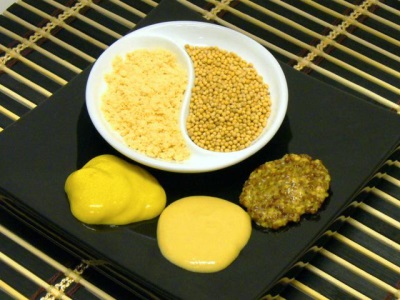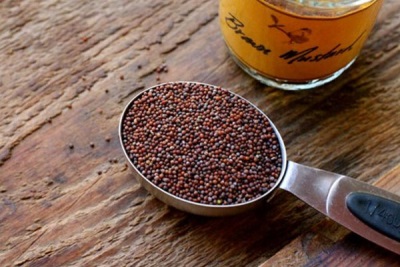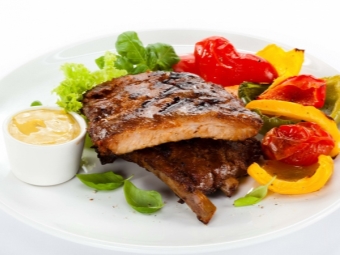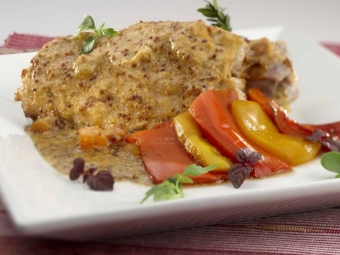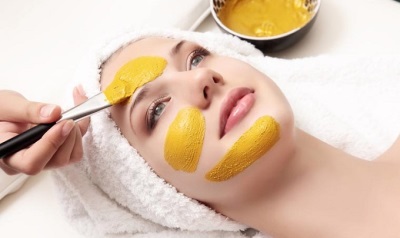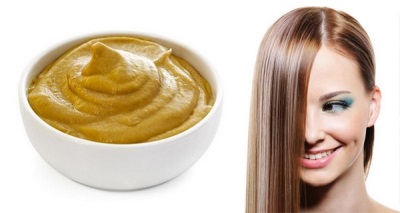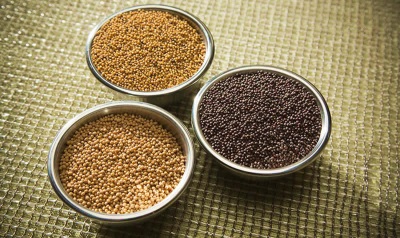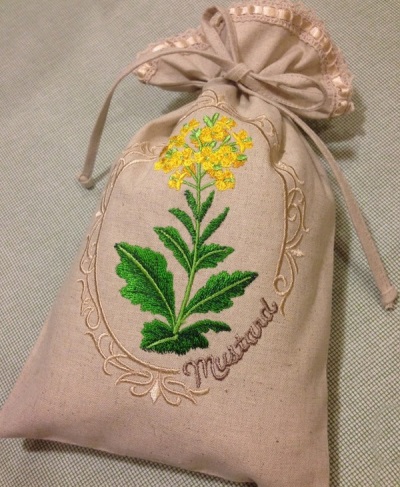Mustard seeds
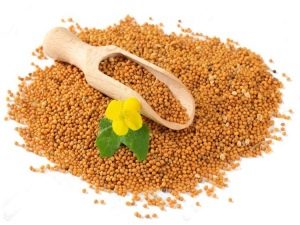
Earth around the world is filled with a wide variety of interesting plants suitable for food or for any other purposes.Some have a specific taste and smell, some plants are poisonous, and some can perform several beneficial functions for the body.
One of these plants is mustard, germinated many centuries ago in Asian countries and has spread around the world.
As a seasoning for many dishes belonging to the cuisine of the Indian people, mustard seeds began to be used quite a long time ago, according to historians, three thousand years before our era. And the first officially observed recipe with mustard was in the forty-second year of our era.
As for the Russian people, for the first time the speech about mustard was introduced in 1781, but it was not seeds or powder that were used, but mustard oil was made, which was used for medicinal purposes, among people suffering from convulsions.
And only relatively recently, mustard seeds have been used as a cosmetic product, which is incredibly useful in many aspects.
What is it?
Speaking of mustard, many are seasoning used in food, quite spicy and sharp in taste, but well complementary to many, mostly meat dishes. As a seasoning, mustard is used in six different versions - white mustard seeds themselves are used, mustard is used in a dry ground form, ordinary table mustard is made in the form of paste, there are also Bavarian, Dijon and French mustard.
Some have associations with mustard powder, often used in the treatment of colds as mustard plasters. But few people thought that mustard is an annual herb that belongs to the cabbage family.
Many gardeners use mustard as a fertilizer, sowing the beds and even whole fields with it, then digging and leaving the plant under a layer of earth in order to produce useful humus.
The traditions of many nations require the use of this plant, giving it a completely different meaning. For example, in Germany it is believed that the mustard seed, enshrined in the bride's attire, promises a reliable, long-term marriage. In Denmark, mustard seeds are used as a talisman against evil forces and protection for the hearth. And in eastern countries, mustard is considered a very strong substance that increases sexual desire, that is, an aphrodisiac.
What do they look like?
The appearance of mustard is quite interesting, in terms of considering the plant as a whole. On a small stalk of medium thickness there are flowers and large leaves, as well as a fruit, from which the well-known seasoning is obtained.
By itself, the fruit resembles a pepper pod with a sharp tip, inside which there are mustard seeds.
There are several types of mustard as a raw material used for the further manufacture of seasoning. White mustard is called English, black seeds are used to make Dijon mustard, and the scientific name of Russian mustard is Sarepta.
Useful and healing properties
- Mustard, being a very powerful tool, has many useful properties in completely different areas of life. When applying mustard as an oil, few people think that it contains vitamins B6, E, D and PP that are beneficial for the body in an easily digestible form.
- Also, mustard seed oil contains elements useful for capillaries, making them stronger and more elastic. In addition, mustard oil increases appetite and improves the functioning of the gastrointestinal tract, stimulating the digestive process.
- Mustard seeds are able to save from headaches and persistent migraines by lowering high blood pressure. This will have a charitable effect on human well-being and will have a positive impact on health in the future.
- Mustard seeds are rich in selenium and magnesium, which very well mitigate any inflammatory processes, as well as a charitable effect on asthma, rheumatism and arthritis attacks, softening them.
Harm
In addition to the many useful properties, mustard seeds can cause irreparable harm to the body, if used and applied inside it in too large quantities.
Therefore, it is necessary to comply with the norm and to use this plant dosed, both in the field of cooking and for medicinal purposes.
Contraindications
Contraindications in the use of mustard can be any diseases that can give an aggressive reaction to the plant, as well as exacerbate the painful situation.
Kidney diseases, tuberculosis, cardiovascular diseases, diseases of the gastrointestinal tract, as well as personal intolerance are the main contraindications to the use of mustard.
Nutritional value and calorie
Energy and nutritional value per 100 grams of product
| Squirrels | Fat | Carbohydrates | Calorie content |
| 25.8 grams | 30.8 grams | 23.4 grams | 474 kcal |
Application
As already mentioned, mustard is used in various spheres of human activity.
- In cooking, mustard is used for making seasoning, which can be used separately, as a paste, similar to ketchup or mayonnaise. Mustard seeds are great for pickling cucumbers and tomatoes and give them a savory, spicy taste.
- Mustard will be an excellent marinade for meat products, highlighting the taste of cooked meat, while retaining all its beneficial properties.
- Already discussed the miraculous medical properties of mustard, but it is also worth mentioning that mustard can be used as a laxative agent, as well as lotions for diseases of the joints.
- In addition to all this, mustard is perfectly used in cosmetology, having the same inexplicable positive effect on the appearance of a person. For example, mustard is used in the preparation of face masks.
Consider one of the recipes.
One tablespoon of mustard powder will need a warm chamomile infusion or brewed green tea, as well as half a teaspoon of olive oil and the same amount of honey.
Then you should thoroughly mix all the ingredients, clean the skin from makeup and parts of dust and apply a mask. After ten minutes, you need to wash your face with a warm extract of chamomile, and then lubricate with a moisturizer.
This mask will help improve the complexion by stimulating blood circulation, as well as reduce inflammation and rash on the skin.
To care for the skin of the body there are also several tricks with the use of mustard.
For example, mustard oil is widely used to care for the skin of the body, because it is incredibly nourishing and has a softening effect on the skin, and also helps burn fat cells, which is why it is used in anti-cellulite massage.
In order to achieve a reduction in waist sizes, wraps with honey and mustard are used, which act on fat burning, acting with light tingling and tingling.
Mustard masks are used for hair care and hair growth. To prepare this mask, you will need two tablespoons of mustard powder, two tablespoons of herbal decoction, such as nettle, chamomile, sage or peppermint, one tablespoon of brandy and one tablespoon of heavy cream or cosmetic oils.
This mixture should be applied to the roots, without affecting the entire length of the hair, then it is necessary to warm the head and leave for half an hour. There will be a slight burning and tingling sensation, but when these sensations are enhanced, the mask must be immediately washed away so as not to harm the scalp.
After the specified time it is necessary to rinse your head with shampoo, use a conditioner balsam. You can also rinse hair with herbal decoction.
Tips for choosing
When choosing mustard seeds in any form, the first thing you should pay attention to is the expiration date, since an overdue seasoning can harm health, and the healing and medical properties will simply be lost.
In addition, it is necessary to pay attention to the composition, color and type of mustard, to choose the one you need. In the composition of granular mustard should not be any other additives, in addition to the seeds themselves.
Storage
Store mustard in a cool place and avoid sunlight. It is better to choose a dark place for this and observe the shelf life - no more than one and a half months, at a temperature of ten degrees. In winter, mustard can be stored for about three months.
Mustard seeds should be kept in small bags made of cloth in order to preserve useful properties.

